Abstract
This paper presents FEM analysis of arch cast partials. Functional tests of such prostheses were carried out. Loads and strains they are subject to were taken into account. An original, proprietary test stand was devised to test cast partials.
1. Introduction
Many domestic and offshore research centres conduct mathematical modelling of dental prosthesis (including implants). Institute of Dentistry of Medical University of Warsaw is one of such institutes. Research and scientific efforts it makes are usually limited to analysing static loads to which biomechanical prostheses are exposed. Hence the Institute of Electronic Systems of Military Technical Academy [10, 11] decided to investigate those issues. It consequently carried out mathematical analysis of dental prosthesis subject to both static and kinematic excitation [8, 12]. Gum soft tissue model was also considered. Those types of issues are very important for speech recognition. Biometric human identification uses such recognition technique [4, 16].
Mathematical models of dental prostheses are a powerful cognitive tool. They allow strain and stress analysis of every surface of dental prosthesis under different external loads applied [13]. This makes possible to estimate longevity of prosthesis, also over the long-term.
Expanding the model to include kinematic excitation and gum soft tissue response will make the virtual prosthesis feasible. Thanks to this the prosthesis could be quickly modified and customised to represent a particular dentition. Such prostheses could be then subject to tests.
The frequency teeth are usually subject to loading during comminution of food is between 40-120 cycles/min [6, 7]. Effective static load applied to the occlusal surface (biting surface) does not exceed 20 N.
Carried out tests and simulations using a flat prosthesis model prove that regardless of 15 N load application point both deflection as well as deformation of prosthesis metal panel were linear [15, 17].
Estimated deflection of prosthesis models should not exceed 5 mm [14]. Deflections occurring during testing, vary depending on test points. For purposes of further considerations they were assumed to vary between ±300 µm/m. The test stand was designed to enable broader measurement scope in order to test for external loads up to 20-25 N [9, 18].
2. Cast partials testing
Research effort was channelled into conducting a numerical analysis of cast partials under dynamic load. The specimen (Fig. 1) used for analysis was a replica of an intraoral prosthesis – a partial denture replacing six teeth and worn by a partially edentulous patient.
Figure 2 and 3 illustrates a purpose-built test station designed to determine and measure model prosthesis responses to dynamic load. At the design stage, emphasis was put on facilitating carrying out diagnostic measurements [2] as well as reliability [15, 23] (of power supply [22] and impact of electromagnetic interference [5]) through putting in place adequate reliability structures [20, 21]. Load application method, load direction and its variance in time were all taken into account [1, 2].
Fig. 1Test prosthesis with highlighted load application points (23-27) [11]
![Test prosthesis with highlighted load application points (23-27) [11]](https://static-01.extrica.com/articles/15747/15747-img1.jpg)
![Test prosthesis with highlighted load application points (23-27) [11]](https://static-01.extrica.com/articles/15747/15747-img2.jpg)
Fig. 2Diagram of test station [11]
![Diagram of test station [11]](https://static-01.extrica.com/articles/15747/15747-img3.jpg)
Fig. 3A block diagram of a system for measuring the prosthesis
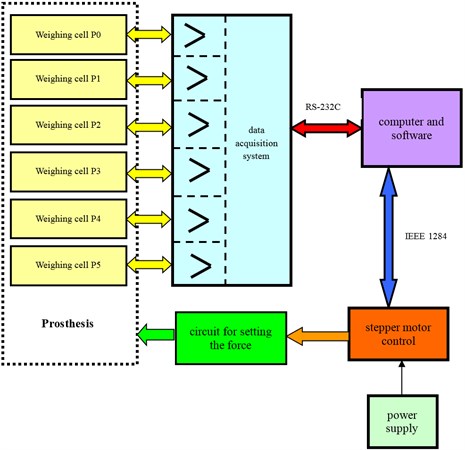
In order to validate empirical measurements taken during tests a numerical analysis of the prosthesis was carried out using the finite element method. Figure 4 illustrates the discretized system (division into finite triangular subregions).
Fig. 4FEM mesh – showing both supporting nodes and nodes with prescribed loads
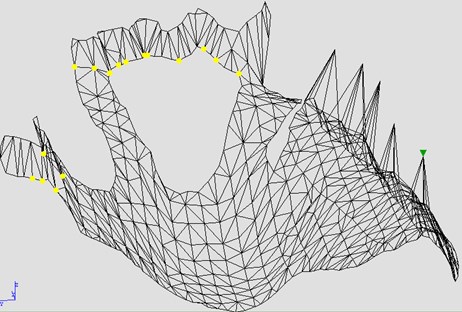
The model prosthesis was cast from Wironit Extra-hard –denture alloy for combination work (certificate 82593, CE 0044 ISO 6871-1).
Load bearing parameters required for numerical analysis are as follows:
Elastic modulus: 170000 N/mm2,
Poisson ratio: 0.3,
Alloy Density: 8.2 g/cm3.
The units used for calculations were consistent throughout – [mm], [N]. Natural vibration of the prosthesis was analysed first (Fig. 5).
Fig. 5Deformation distribution under the first natural frequency
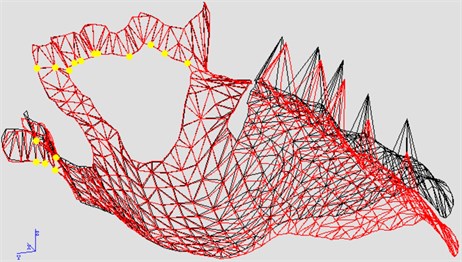
The model prosthesis is a “fine-tuned” system. This guarantees that neither natural vibrations would be within the range of assumed harmonic vibrations. Further computations and simulations validated that.
Numerical analysis of displacements was carried out with test load applied to node 27 (Fig. 1, 3) – causing greatest deflection of the prosthesis. Out of necessity, only the results for maximum deflections were compared.
Figures 6 and 7 illustrate variability of maximum deflection over half period cycles (one cycle) and over 1.5 T.
Figure 8 illustrates deformation and Figure 9-11 state of stress under maximum stress applied.
Fig. 6Maximum deflection over 0-0.5 sec
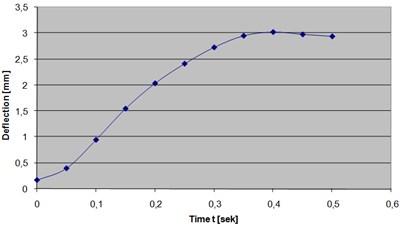
Fig. 7Maximum deflection over 0-1.5 sec
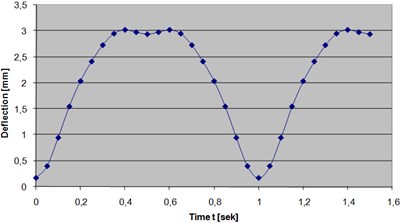
Fig. 8Prosthesis deformation distribution for t= 0.5 sec
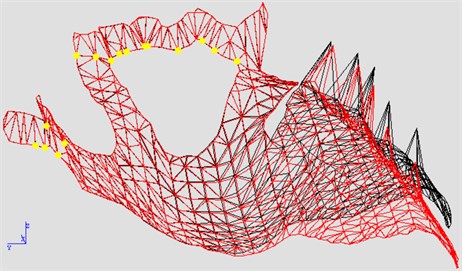
Fig. 9Main stress distribution
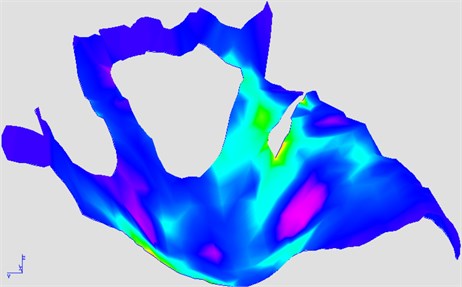
Fig. 10Destructive stress distribution according to Huber-Hencky-von Mises
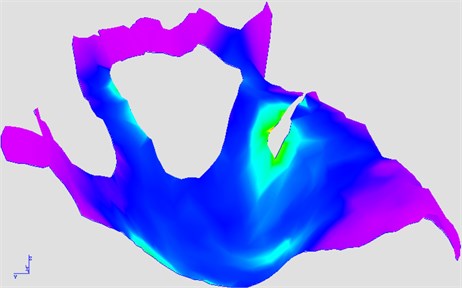
Fig. 11Distribution of maximum (main) bending moments
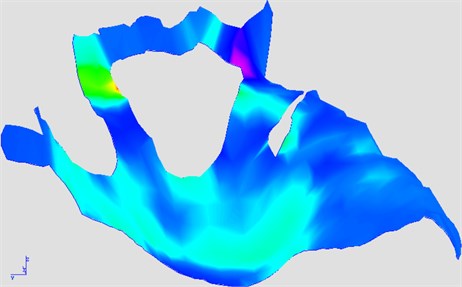
3. Conclusions
This paper discusses issues related to arch cast partials. Completed numerical analyses of the partial denture using the finite element method turned out to have validated measurements taken at the real, original test station. Consequently preliminarily taken assumptions were validated as well as the protocol followed for taking measurements and the subsequent simulation. Plans for further research into this issue include developing a dedicated, proprietary software which would expand capabilities of the Mikro-Strains System.
References
-
Burdzik R. Implementation of multidimensional identification of signal characteristics in the analysis of vibration properties of an automotive vehicle’s floor panel. Eksploatacja i Niezawodnosc – Maintenance and Reliability, Vol. 16, Issue 3, 2014, p. 439-445.
-
Burdzik R., Konieczny Ł., Figlus T. Concept of on-board comfort vibration monitoring system for vehicles. Mikulski J. (Ed.), Activities of Transport Telematics, TST 2013, CCIS 395, Springer, Heidelberg, 2013, p. 418-425.
-
Dabrowski T., Bednarek M., Fokow K., Wisnios M. The method of threshold-comparative diagnosing insensitive on disturbances of diagnostic signals. Przeglad Elektrotechniczny – Electrical Review, Vol. 88, Issue 11A, 2012.
-
Dobrowolski A. P., Majda E. Application of homomorphic methods of speech signal processing in speakers recognition system. Przeglad Elektrotechniczny – Electrical Review, Vol. 88, Issue 6, 2012, p. 12-16.
-
Duer S., Zajkowski K., Duer R., Paś J. Designing of an effective structure of system for the maintenance of a technical object with the using information from an artificial neural network. Neural Computing and Applications, Vol. 23, Issue 3-4, 2013, p. 913-925.
-
Henderson D., McGivney G. P., Castleberry D. J. McCracken’s removable partial prosthodontics. C. V. Mosby Co. St. Louis, 1985.
-
Hupfauf L., Niedermeier W. Partial dentures. Kinematics of dentures, Urban & Partner, Wrocław, 1997, (in Polish).
-
Kuchta M., Chwaleba A., Gryszkiewicz M. Experimental verification of deflection backbone modeling dentures with separate kinematics. X School Computer-Aided Design, Manufacturing and Maintenance, Jurata, 2006, p. 91-97, (in Polish).
-
Kuchta M., Kwiatos K., Fokow K. Set-up diagnostic tests dentures. Diagnostics, Vol. 39, Issue 3, 2006, p. 187-193, (in Polish).
-
Kuchta M., Paś J., Siergiejczyk M. Cast partials analysis using a proprietary test station. Vibroengineering Procedia, Vol. 3, 2014, p. 395-398.
-
Kuchta M., Siergiejczyk M., Paś J. Numerical analysis of cast partials using the finite element method. Vibroengineering Procedia, Vol. 3, 2014, p. 288-291.
-
Kuchta M., Szulim M. Electronic measurement set for diagnostic dentures with dynamic excitations. Przeglad Elektrotechniczny – Electrical Review, Vol. 12b, 2011, p. 96-100, (in Polish).
-
Kuchta M., Wnuk M. Modeling elastic support dentures. Electrical Review, Vol. 12, 2010, p. 79-82, (in Polish).
-
Kydd W. L., Daly C. H., Wheeler J. B. The thickness measurement of masticatory mucosa in vivo. International Dental Journal, Vol. 21, Issue 4, 1971, p. 430-441.
-
Laskowski D., Łubkowski P., Pawlak E., Stańczyk P. Anthropo-technical systems reliability. Safety and Reliability: Methodology and Applications – Proceedings of the European Safety and Reliability Conference, ESREL, 2014, p. 399-407.
-
Majda E., Dobrowolski A. P. Modeling and optimization of the feature generator for speaker recognition systems. Przeglad elektrotechniczny – Electrical Review, Vol. 88, Issue 12A, 2012, p. 131-136.
-
Michalski W., Michniowski Z., Kuchta M., Chwaleba A. Numerical simulation of mechanical behavior and reactions of the wing base of the upper denture – model flat. Protetyka Stomatologiczna – Prosthodontics, Vol. 3, 2005, p. 197-206, (in Polish).
-
Michalski W., Kuchta M., Fokow K. Tensometric experimental measurements of mechanical wing for the numerical simulation of dentures. Materials Conference VII Symposium on Modeling and Measurement in Medicine, Krynica, 2005, p. 197-203, (in Polish).
-
Niedermeier W. The fitting behavior of rigid free-end prostheses. Deutsche Zahnarztliche Zeitschrift, Vol. 35, Issue 3, 1980, p. 394-396, (in German).
-
Rosinski A. Reliability analysis of the electronic protection systems with mixed m-branches reliability structure. Proceedings of International Conference European Safety and Reliability, ESREL, 2011, p. 2064-2071.
-
Rosinski A. Reliability analysis of the electronic protection systems with mixed – three branches reliability structure. Proceedings of International Conference European Safety and Reliability, ESREL, 2009, p. 1637-1641.
-
Rosinski A., Dabrowski T. Modelling reliability of uninterruptible power supply units. Eksploatacja i Niezawodnosc – Maintenance and Reliability, Vol. 15, Issue 4, 2013, p. 409-413.
-
Siergiejczyk M., Paś J., Rosiński A. Evaluation of safety of highway CCTV system’s maintenance process. The monograph „Telematics – support for transport”, Ed. Jerzy Mikulski, given as the monographic publishing series – „Communications in Computer and Information Science”, Vol. 471, Springer-Verlag, Berlin Heidelberg, 2014.
